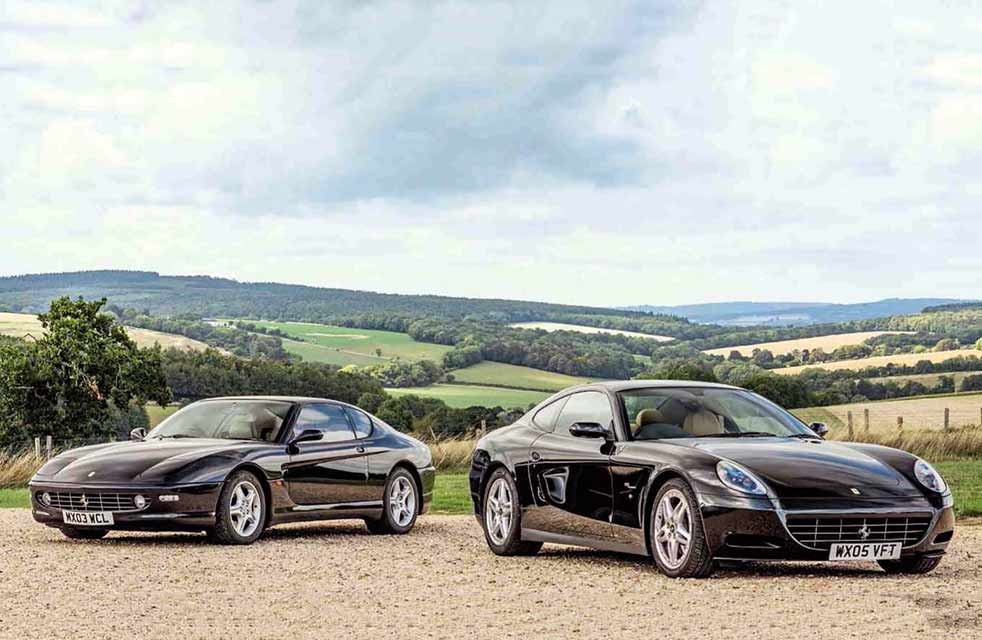
Ferraris for four – 456 GT v 612 Scaglietti – battle of the 2+2s. Magnificent V12 engines, enough room inside to take the family, and at the more affordable end of Ferrari ownership… We sample 456 GT and 612 Scaglietti. Words John Barker. Photography Alex Tapley.
FERRARIS FOR FOUR Four-seater Ferraris 456 GT meets 612 Scaglietti. Two Ferraris for the family man, but which is the more convincing? John Barker decides.
Just the thought of owning a V12 Ferrari feels indulgent. Realising the ambition tends to depend on being well-heeled – or being prepared to take a sizeable gamble on a running restoration, where the cars gets fixed as it goes wrong. But there are a couple of ways of having a useable and reliable V12 in your life for a reasonable sum. Sure, they’re four-seaters rather than cosy berlinettas or breezy spiders, but then, being able to take the family along might well be the clincher.

They are the 456 GT and 612 Scaglietti. The older and arguably more handsome of the pair is the 456. Launched in 1993, it was the first all-new car of the Montezemelo era and was a valuable donor to the brilliant 550 Maranello in terms of both components and learning. While no family-sized 550, it proved appealingly more dynamic than the long-lived, crisp-edged 365/400 series model it replaced.
The 456’s all-new 5.5-litre V12 developed 436bhp and, with carefully tuned aerodynamics including an active front spoiler, the 456 would push on to an impressive 186mph, allowing it to claim the title of the world’s fastest four-seater GT. What’s more interesting is that, while most of the 400 generation cars were slush-pumping autos, the 456 was initially available only as a manual; it wasn’t until 1996 that a four-speed auto was offered.
Our example is a 456M and is one of the very last, registered in 2003. Not a great deal changed when the M version was introduced in 1998: the interior was re-worked, the active spoiler was replaced. It was Modificato pianissimo. The engine was unchanged but by this time the auto-equipped GTA version was much more popular, making our car, a six-speed manual, something of a rarity.
Rarer still is the manual 612 Scaglietti. By the time the 612 replaced the 456 in 2004, Ferrari was enthusiastically rolling out its ‘F1’ gearbox, its two pedal, automated manual. Of the 3025 612s built over six years, only 199 were fitted with the manual. Frankly, I’m surprised it’s that many. Not because it’s a poor shift – quite the contrary – but because sitting on a raised plinth on the centre console it looks very much like an afterthought or an aftermarket conversion. It’s as if management had a change of heart at the last minute.
The 612 was a new-era car. While the 456 was traditionally built with an aluminium body over a tubular steel chassis, the 612 was Ferrari’s second all-aluminium production car venture with Alcoa, the first being the 360 Modena. It’s much bigger than the 456, partly to better accommodate four people but also to give the weight distribution that Ferrari’s engineers had deemed optimum for dynamics. Although the V12 was up front, they wanted the masses distributed as in a mid-engined car, which goes some way to explaining the long nose and wheelbase.
Given its construction, at 1875kg the 612 was perhaps heavier than expected (the 456 was 1690kg, or 1770kg with the auto) but buried deep in its nose was a new, much more potent 5.7-litre V12, first seen in the 575M Maranello and churning out a lusty 533bhp. In the game of ‘guess what the numbers mean’, the 456 can be traditionally deciphered, the number being the individual cylinder capacity of its V12. And the 612? Well, it’s not 612cc per cylinder or even a 6-litre V12. It’s just a good number, and the 5748cc V12 powers the 612 to another good number: 199mph, according to Ferrari’s claims. Meanwhile, the 612’s weight distribution gave superb traction that helped the big four-seater to sprint to 60mph in just 4.3sec, almost a whole second faster than the 456.
At the time of the 612’s launch, I felt the ungainly styling was a high price to pay for the dynamic benefits and more generous, family-sized accommodation. Yet here I am, over a decade later, tailing the briskly driven 612 into and through a sunlit roundabout thinking: ‘You know, that looks pretty darned good!’ I reckon it helps that it’s in black (a colour the press office would have avoided) and wearing five- spoke split-rim alloys, but maybe time has mellowed it, too.
Adding to this 612’s appeal, it’s one of just 23 UK manuals. Three pedals and a ball on a stick sounds charmingly retro in these days of all-singing dual-clutch transmissions that offer the convenience of an auto and the connectedness of a manual. (Mind you, the imperfect FI auto with its computer-managed single-plate clutch sounds rather quaint, too.) But the truth is that if you want to enjoy an engine, any engine, want to really control it and understand its character, and really connect with the car, too, a manual is the only way. The fact that we’re talking about Ferrari V12s only makes the reason to want that connection even greater.
It’s been a long time since I’ve driven a 456. I’m no taller than I was back then, still 5ft 8in (although, ahem, maybe a bit bigger around the waist), but from the wheel it feels smaller than expected. The footwell feels tight, and while the seat adjusts electrically for cushion height and rake, backrest angle and lumbar inflation, fundamentally it feels like a small seat, short under my thighs. I can still get a good driving position, though, helped by the adjustable steering column.
The scuttle is low, giving a generous, clear view out, and the instrument markings have a marvellous old-fashioned look that suggests they might have been painted by a steady-handed artisan. The numbers are properly modern, though, the tachometer going all the way to 10 and the speedo to 220mph.
Twist the key and the 456’s V12 fires up undramatically, quickly settling into a light- noted, quietly complex, smooth idle. Slot the lever into top left of the open metal gate, ease the clutch back up – its action is moderately weighty but easily modulated – and the 456 glides away on tickover. Second gear is a bit tight initially – proper Ferrari! – but you quickly get the measure of the efforts and the throws and can set about finessing those shifts.
The V12 makes little more than a murmur at a cruise, but it’s surprisingly tactile through the throttle pedal, which zizzes under your right foot. It’s a remarkably tractable engine; top gives just shy of 30mph per lOOOrpm yet the V12 picks up instantly and with gusto from idle, so you don’t need to change gear often.
But you do, because having fine control of the instrument that is the V12 is so very rewarding. The seamless second-gear heel-and- toe downshift is the ultimate challenge; feeling the resistance at the lever soften in your palm as the revs match up, and blending the clutch back in without a bump. Every shift offers reward, a chance to do a job well, and an opportunity to enjoy the delivery of the engine, too, to feel it climb the changing gradient of its torque curve and hear its note reflect this.
It’s a quick car, the 456, one that enjoys revs, and its spirit will encourage you to explore the handling. It feels soft initially, the steering slow to respond, but once committed to a turn there’s some magic; a poise and balance that’s natural and exploitable. The 456 flows. In corners and curves it feels connected, responsive to both steering and throttle, and lighter on its feet than you expect. By current standards it has small wheels (17in diameter) with tall tyres, so you’d expect a smooth ride, but while it’s good in large movements, in detail it’s jiggly. This is at odds with my recollection and that of Rardley Motors, who sold this car to its current owner some years ago; the very old tyres it’s wearing are the suspected culprit here.
It’s not a full four-seater, certainly not a place for four adults. Slot yourself past the front seat and the bucket that awaits you proves small, with limited knee-room – and that’s me, of average height, sitting behind the driver’s seat adjusted for another me. There’s not enough headroom either, though to be fair it was described as a 2+2, and if your +2 was a pair of small children, it would be fine.
The 612 is a much longer car, in overall length and wheelbase. It’s built to a deceptive scale, appearing smaller on its own, disguising how roomy it is inside. Comparing the two, the 612’s cockpit is much bigger. Swing open the long door, flip the seat forward, wait for it to motor forward, then climb in and make yourself comfy. And you can. For me, there’s plenty of head- and knee-room and the seat is well shaped, the forward view good, the ambience light and airy. It feels as though four grown-ups could travel hundreds of miles in comfort. It would help if they travelled light, though; the boots of both the 612 and the 456 are just big enough rather than generous, offering space for a few squashy bags or a set of golf clubs.
The open gearshift sitting on its plinth might look like an add-on, but within a couple of miles it’s apparent that its action is more polished than the 456’s, as though a few more burrs have been filed off the tines of the gate.
In fact, the further you driver it, the more you appreciate what a complete joy it is to use. It’s almost as if the manual gearbox engineers, seeing that this might be one of their last projects, decided to do a stellar job, to make a point, regardless of the fact that very few customers were likely to go manual and appreciate their efforts. With the FI ‘box being the thing of the moment, back in the day we in the press wouldn’t have seen a manual. Which is a shame, because it is quite wonderful.
Despite being a bigger, heavier car, the 612 doesn’t feel it; as with the 456, it will lunge forward effortlessly from tickover in a high gear, the difference being that the urge gets stronger more quickly. The 612 is properly quick, a fast, powerful car even by current standards. Again as with the 456, it’s not a vocal engine, the V12’s voice more whirr than growl, but there’s a lot more horsepower and torque to play with and to exploit with the manual gearbox, including a thrilling 8000rpm top-end that’s there for when you’re on your own.
Adding to its Grand Tourer credentials, the ride of the 612 is wonderfully supple right from the off. It deals with coarse surfaces calmly and quietly, and rides B-road swells and dips every bit as well as you’d hope a long-wheelbase GT would. The steering takes a little getting used to, being faster-geared than the 456’s but a little less positive about the straight-ahead, which means that the newer car demands a little more attention.
Its handling is wonderfully exploitable, though. It manages to be more settled than the 456 yet more agile and biddable, too. The way it will snick in and out of roundabouts, poised and with the option of mild rear slip and easy throttle-adjustment of line justifies Ferrari’s pursuit of that dynamic balance.
Both these cars are dominated by their V12 engines, and despite how wonderfully tractable they are, their manual shifters make more sense than you’d imagine. Not because you want to drift them, but because their chassis are engaging and adjustable and invite precise control, which is what the direct connection of a manual and the instant response of the V12 dish up. They also add the challenge of driving them with finesse, honing your skills, and that in turn delivers great satisfaction, whether you’re pressing on or simply ambling along.
Add in the fact that little goes wrong with the 456 and even less with the 612 and they both look like excellent ways to get behind a Ferrari V12. I’ve always admired and hankered after a 456 but a Scaglietti would be my choice; it’s better to drive and a full four-seater. Handsome in the right colour, too. I wasn’t expecting that.
With thanks to Rardley Motors, who have the 612 for sale.
‘The 612 Scaglietti is properly quick, a fast, powerful car even b current standards’
TECHNICAL SPECIFICATIONS FERRARI 456M GT
ENGINE V12, 5474cc
MAX POWER 436bhp @ 6250rpm
MAX TORQUE 405lb ft @ 4500rpm
TRANSMISSION Six-speed manual transaxle, (auto option), limited-slip differential
SUSPENSION Front and rear: double wishbones, coil springs, telescopic dampers, anti-roll bar
STEERING Rack-and-pinion, hydraulically assisted
BRAKES Vented discs, 330mm front, 310mm rear, ABS
WHEELS 8.5 x 17in front, 10 x 17in rear, aluminium alloy
TYRES 255/45 ZR17 front, 285/40 ZR17 rear
WEIGHT 1690kg
POWER TO WEIGHT 262bhp/ton 0-60MPH 5.1sec (tested)
TOP SPEED 186mph (claimed)
PRICE NEW £170,358 in 2003 (£264,000 in today’s money)
VALUES TODAY £50,000-£70,000
TECHNICAL SPECIFICATIONS FERRARI 612 Scaglietti
ENGINE V12, 5748cc
MAX POWER 533bhp @ 7250rpm
MAX TORQUE 434lb ft @ 5250rpm
TRANSMISSION Six-speed manual transaxle (F1 option), limited-slip diff, CST
SUSPENSION Front and rear: double wishbones, coil springs, electronically adjustable telescopic dampers, anti-roll bar
STEERING Rack-and-pinion, hydraulically assisted
BRAKES Vented discs, 345mm front, 330mm rear, ABS
WHEELS 8 x 18in front, 10 x 19in rear, aluminium alloy
TYRES 245/45 ZR18 front, 285/40 ZR19 rear
WEIGHT 1875kg
POWER TO WEIGHT 291bhp/ton
0-60MPH 4.3sec (tested)
TOP SPEED 199mph (claimed)
PRICE NEW £177,500 in 2006 (£253,000 in today’s money)
VALUES TODAY £65,000-£125,000
‘Both are dominated by their V12 engines… their chassis engaging, inviting precise control’
From far left – 612 Scaglietti’s 5.7-litre V12 was a development of the one that had first appeared in the 575M Maranello a couple of years earlier and tuned to make even more power: 533bhp at a heady 7250rpm. Rear accommodation more generous than in 456: 612 is a genuine four-seater. Below and right 5.5-litre V12 was brand new for the 456 in 1993 and little changed for the 456M version (as featured here) which came along in 1998. Peak power was 436bhp at 6250rpm. Rear seats better suited to children than adults, but then Ferrari only ever described it as a 2+2. Above and right Clear family likeness between 612 (on the left) and 456, the car it replaced in 2004. Interior of 612 (right) is very much of the modern Ferrari era, which makes the rare manual gearshift a real anachronism (if a very enjoyable one).
‘A manual 456 is something of a rarity. Rarer still is a manual 612’
‘The 456 flows. In corners and curves it feels connected, responsive to both steering and throttle’









